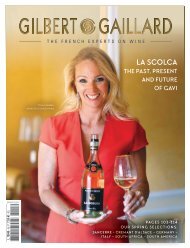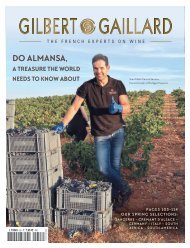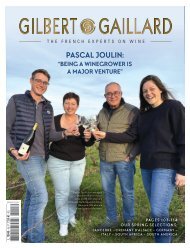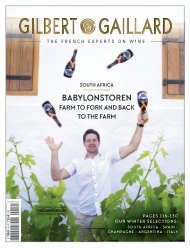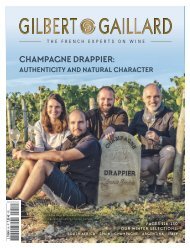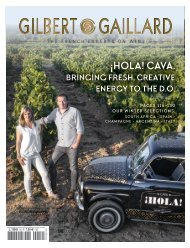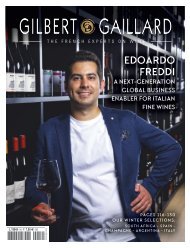You also want an ePaper? Increase the reach of your titles
YUMPU automatically turns print PDFs into web optimized ePapers that Google loves.
MATHIEU ZOELLER, HIS SON HECTOR AND WIFE<br />
CHRISTÈLE WHO JOINED THE ESTATE IN 2003<br />
THE RUHLMANN-SCHUTZ FAMILY<br />
aromas and body”. The property’s ethos has always revolved around producing ripe, healthy<br />
fruit, rather than relying on artifice in the winery. “The classic range is more fruit-driven”, adds<br />
Christèle Zoeller. “The percentage of Pinot blanc in the blend is high because the varietal is<br />
more delicate and more floral than Pinot Auxerrois which imparts ripe, slightly buttery notes”.<br />
LES VIGNOBLES RUHLMANN-SCHUTZ:<br />
THE HEIGHT OF FRESHNESS<br />
The history of this winery dates back to 1688. A Hungarian knight called Ruhlmann moved to<br />
Dambach-la-Ville and decided to grow vines. Down through the generations, winegrowing<br />
developed and there are now 40 hectares under vine. In 1994, the winery was given its current<br />
name. Laurence Ruhlmann, Christine and Jean-Victor Schutz left their jobs to join André<br />
Ruhlmann and establish Vignobles Ruhlmann-Schutz. The vineyards benefit from an outstanding<br />
location along the Rhine Valley, growing on the slopes of the Vosges at elevations<br />
ranging from 175 to 420 metres, where a geological fault line creates a variety of complex soils.<br />
The geographical distribution of the vines allows each variety to enjoy the most suitable site.<br />
Twenty percent of the wines are sparkling. “The fruit for our Crémants comes from vineyards<br />
on clay-limestone and sometimes granite soils”, explains export director Antoine Schutz. “The<br />
blend for our Crémant Brut is unique – it has a classic Pinot blanc Auxerrois base with a trace<br />
of Riesling for acidity and fruit input from the Pinot gris. These combine to promote maximum<br />
freshness”. Time spent on the lees for the Brut and Rosé Crémants is generally 12 months,<br />
rising to 18 months for the Extra Brut. “Obviously, we offer a great alternative to Champagne”,<br />
adds Schutz. “This is a real advantage in export markets which are demanding but growing”.<br />
28 SPRING 2024 • GILBERT & GAILLARD - THE FRENCH EXPERTS ON WINE




